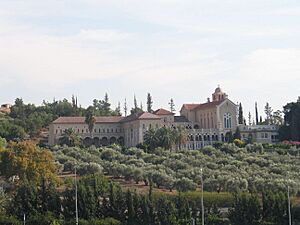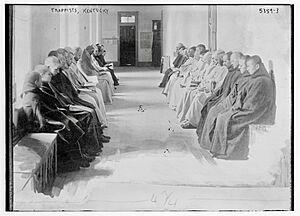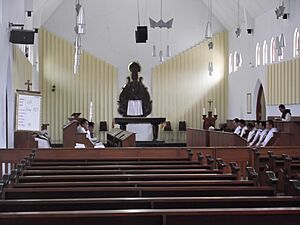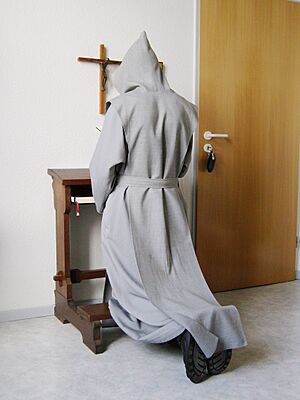Trappists facts for kids
|
Ordo Cisterciensis Strictioris Observantiae
|
|
Logo of the Trappists
|
|

Armand Jean le Bouthillier de Rancé, the founder of the Trappists
|
|
| Abbreviation | OCSO |
|---|---|
| Formation | 1664 |
| Founder | Armand Jean le Bouthillier de Rancé |
| Founded at | La Trappe Abbey |
| Type | Catholic religious order |
| Headquarters | Viale Africa, 33 Rome, Italy |
|
Abbot General
|
Bernardus Peeters |
|
Parent organization
|
Catholic Church |
The Trappists are a special group of Catholic monks and nuns. Their official name is the Order of Cistercians of the Strict Observance. They are called Trappists because their story began at a monastery called La Trappe Abbey in France.
These monks and nuns live a quiet life, mostly separate from the outside world. They follow a set of rules called the Rule of Saint Benedict, which helps them live a simple and prayerful life. The Trappist order started with some changes made by Abbot Armand Jean le Bouthillier de Rancé in 1664. Over time, these changes led to the Trappists becoming their own separate religious order in 1892.
Contents
History of the Trappists
The Trappist story began at La Trappe Abbey in Normandy, France. A man named Armand Jean le Bouthillier de Rancé was in charge of this monastery. At first, he wasn't a monk himself, but he later decided to join the monastery fully in 1663.
In 1664, de Rancé wanted to make the monks' lives more focused on prayer and hard work. He brought in strict rules for the monastery. These rules included lots of manual labor, keeping quiet most of the time, eating very simple food, and staying away from the outside world. The hard work helped the monastery support itself, so they didn't need much from others.
Other Cistercian monasteries liked de Rancé's ideas and started to follow his reforms. These monasteries became known as "Trappist" monasteries, named after La Trappe.
During the French Revolution in 1792, many monasteries, including La Trappe, were taken over by the French government. The Trappist monks had to leave. One monk, Augustin de Lestrange, led some monks to find new homes. They traveled to different countries, trying to keep their way of life. Eventually, they were able to return to La Trappe.
Over the years, different Trappist groups had slightly different rules. To bring them all together, they officially formed a new, single order in 1892. This new order was approved by Pope Leo XIII.
A famous Trappist monk was Thomas Merton. He was a writer and poet who joined the Abbey of Gethsemani in 1941. His books about spiritual life were very popular in the 20th century. One of his well-known books is The Seven Storey Mountain.
The first Trappist to become a saint was Rafael Arnáiz Barón. He was a young man who lived a very religious life despite having diabetes mellitus. He died in 1938 at age 27. He was made a saint in 2009 by Pope Benedict XVI.
Monastic Life
Trappists follow the Rule of Saint Benedict very closely. This is why they are called "Strict Observance." They make three promises: to stay in their monastery, to be faithful to monastic life, and to obey their leaders.
Trappists try to speak only when necessary. This helps them stay focused on prayer and quiet thinking. They don't take a "vow of silence," but they do try to avoid unnecessary talk. They even developed a special monastic sign language to communicate without speaking. During meals, they usually eat in silence while listening to someone read aloud.
Unlike some other monks, Trappists do not eat meat from four-legged animals like pigs or cows. However, they do eat poultry, fish, and seafood. Their diet mainly consists of vegetables, beans, and grain products.
A Day in the Life
The daily life of a Trappist monk or nun is centered around prayer. The exact schedule can change a little between different monasteries, but here is a typical day:
- 3:30 AM | Wake up
- 4:00 AM | Morning prayers (Vigils), followed by quiet meditation or personal prayer
- 5:30 AM | Breakfast
- 6:30 AM | Morning praise (Lauds)
- 7:30 AM | Daily Mass (10:00 AM on Sundays)
- 8:00 AM | Time when the "Great Silence" ends (they can speak more freely for a while)
- 8:30 AM | Mid-morning prayers (Terce)
- 9:00 AM | Morning work period begins
- 12:00 PM | Midday prayers (Sext)
- 12:15 PM | Dinner
- 12:45 PM | Rest time
- 1:30 PM | Afternoon prayers (None)
- 1:45 PM | Afternoon work period begins
- 5:00 PM | Supper
- 6:00 PM | Evening prayers (Vespers)
- 7:30 PM | Night prayers (Compline)
- 8:00 PM | "Grand Silence" begins again, and they go to bed
Becoming a Trappist
Becoming a Trappist takes many years. Here are the general steps:
- Visiting: People interested in becoming a Trappist visit a monastery. They talk to a leader to see if this life is right for them. They might live in the monastery for about a month to experience it.
- Postulancy: If they decide to continue, they live as a "postulant" for several months. They learn more about the monastic life.
- Novitiate: Next, they receive the monk's or nun's clothing and are officially welcomed. This stage lasts two years, and they continue to learn and grow.
- Temporary Vows: After the novitiate, they make temporary promises (vows) to live the Trappist life. This stage can last from three to nine years. It's a time to study and practice their faith more deeply.
- Final Vows: Finally, after all these stages, they make their final vows for their entire life.
Manual Labor
Working with their hands is a very important part of Trappist life. The Rule of St. Benedict says that monks should "live by the work of their hands." This work helps the monastery support itself and also helps the monks grow spiritually.
Trappist monasteries produce many different goods. Some make cheeses, bread, and other foods. Others might make clothing or even coffins. Their most famous products are Trappist beers. These beers are known for being very high quality. The monks brew beer for themselves and to sell to the public.
For example, the Trappist monks at Tre Fontane Abbey in Italy raise lambs. The wool from these lambs is used to make special scarves called pallia for new archbishops.
The monks at New Melleray Abbey in Peosta, Iowa, USA, make wooden caskets.
There is also one Trappist school left in the world, Cistercian College, Roscrea, in Ireland. It is a boarding school for boys.
Famous Trappists
Here are a few people from the Trappist order who are recognized for their holy lives:
- Rafael Arnáiz Barón (1911-1938): He was made a saint in 2009.
- Maria Gabriella Sagheddu (1914-1939): A nun who was recognized as "Blessed" in 1983.
- Cyprian Michael Iwene Tansi (1903-1964): A Nigerian priest who was recognized as "Blessed" in 1998.
- Christian de Cherge and 6 Companions (died 1996): These monks were recognized as "Blessed" in 2018.
Trappist Communities Around the World

Trappist monasteries have spread all over the world. In the last 60 years, the number of Trappist monasteries has more than doubled! In 1940, there were only 82 monasteries, but by the early 2000s, there were 169. Many new monasteries have been built in Africa, Asia, and Latin America.
As of 2018, there were about 1,796 Trappist monks and 1,592 Trappistine nuns worldwide.
How the Order is Organized
Even though each Trappist monastery is independent, they are all connected and work together through a few important systems:
- Regular Visitation: A special leader, called a "Father Immediate," visits each monastery about every two years. This visit helps support the local abbot or abbess and makes sure the community is doing well.
- General Chapter: This is the highest authority of the Trappist order. All the abbots and abbesses meet every three years for about three weeks. They make important decisions for the whole order and elect the Abbot General.
Leaders of the Order
The Abbot General is the main leader of the entire Trappist order. They are chosen by the General Chapter and live in Rome, Italy. The current Abbot General is Dom Bernardus Peeters.
Here are the Abbots General since the order was formally created:
- 1892–1904: Sébastien Wyart
- 1904–1922: Augustin Marre
- 1922–1929: Jean-Baptiste Ollitraut de Keryvallan
- 1929–1943: Herman-Joseph Smets
- 1943–1951: Dominique Nogues
- 1951–1963: Gabriel Sortais
- 1964–1974: Ignace Gillet
- 1974–1990: Ambroise Southey
- 1990–2008: Bernardo-Luis-José Oliveira
- 2008–2022: Eamon Fitzgerald
- 2022–present: Bernardus Peeters
Images for kids







